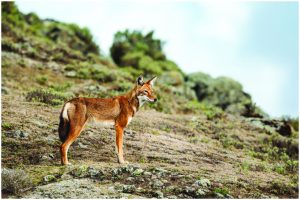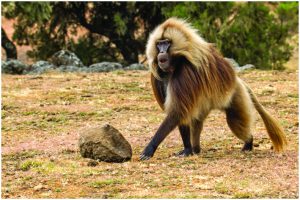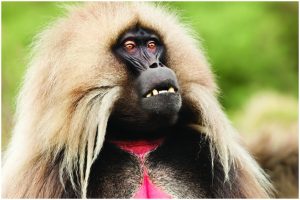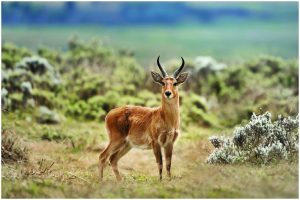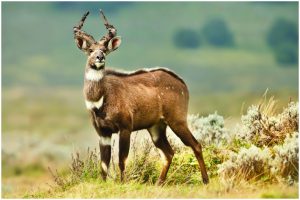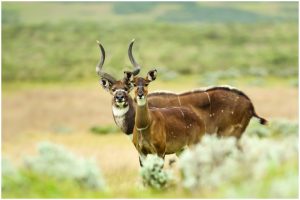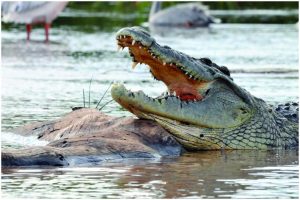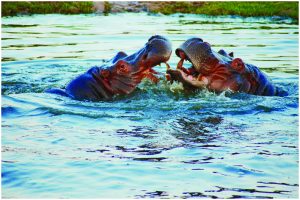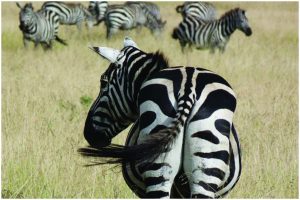Wildlife
Ethiopia has wonderful mammals that exist nowhere else in the world. Mainly the country’s topography has helped them to survive in their particular niches.
The Ethiopian Wolf (Canis simensis) is one of the most endangered canids on earth. It lives in Ethiopia and Eritrea at altitudes of 3,000 meters. It is estimated that about 550 individuals exist. Their diet consists primarily on rodents, he hunts alone, and digs out their burrows at night. The Ethiopian Wolf is a social animal, which forms hierarchical packs of 3-13 individuals. A recent study showed that the Ethiopian Wolf is more closely related to grey wolves and coyotes than the foxes they resemble. The Ethiopian Wolf, Simien Fox or also Simien Jackal is listed as endangered (EN) and stands on the IUCN Red List of Threatened Species. It can be spotted in the Bale Mountains as well as around the Guassa plateau.
The Gelada Baboon is not in fact peculiar to the Simien Mountains, but they are more numerous here than in their other habitats. They might be the only mammal endemic to Ethiopia that cannot be regarded as endangered. The male Gelada is a spectacularly handsome and distinctive beast, possessed of an imposing golden mane and an hour-glass shaped red chest patch. This patch is sort to serve the same purpose as colourful buttocks of other African monkeys that don’t spend most of their time on their buttocks to graze. The social behaviour of the apes and monkeys is evidence of a very high degree of intelligence and studies of their rudimentary social structures are proving considerable value in analysing the origins of human social behaviour. Geladas live along the edges and steep slopes of precipices. They never move far from the rim and thus their distribution is linear along the escarpment. At night they climb down the steep cliff faces to caves where they roost on ledges, often huddled close together for warmth as nights in the highlands can be very cold. Babies cling tight to their mothers even in sleep. In the morning in the warm sun they climb up again to the top of the cliff and spread out to feed. Geladas are mainly vegetarian, living on herbs, grasses and roots, but they also eat insects and locusts. They never eat meat, or hunt or kill even small birds or mammals. The harem is a very close family unit. Ninety-five percent of the social interactions of adults are with other members of the same harem. Only juveniles and babies cross the invisible boundaries to play with others of their own age. Gelada Baboons can be spotted around the Simien Mountains, Debre Libanos, the Muger River Gorge, Debre Sina, Ankober and the Guassa Plateau.
The habitat of the endemic Walia Ibex is the Simien Mountain range in the northern part of the country. In this scenic splendour live the Walia Ibex, here and nowhere else in the world. The Walia once existed in significant numbers probably several thousands in the highland massif, feeding on the cliff faces and coming up to roam the plateau at rutting time. Large herds wandered unmolested on these chilly heights. The increasing number of humans in that area has pushed the Walia Ibex deeper into the Simien Mountains. The Walia Ibex is a type of goat. Both males and the females have horns, but the males’ are much bigger. Curving back in a graceful arc to the withers they sometimes attain a length of over 110 cm. Females are smaller in body and lighter in colour with shorter, thinner horns. They live in small parties of two to half a dozen and the big old males often live solitary except during the mating season. Because of the rarity of the animal, it is not often possible to observe a large male and one feels privileged to do so. The magnificent horns and striking colouration make it an unforgettable sight. They can be easily spotted around the third camp of the Simiens called “Chenek”.
The Mountain Nyala was the last of the great African antelopes to become known to science. Still today very little is known about its habits or the full extent of its range. It was first collected by Major Ivor Buxton in 1908 and at that time seemed to be fairly widespread throughout the Arsi and Bale regions in south eastern Ethiopia. Large numbers of them lived at very high altitudes, between 3,000 and 4,000 m, in the mountain forests where it was cold and wet much of the time, until the pressure of the human population destroyed vast tracts of their forest habitat. There are white markings on the legs and two white spots on the face, a white chevron between the eyes. Nyala are similar to Greater Kudu but can be distinguished by the single spiral horns and the absence of clear white stripes on the body. Those of the Nyala are only faintly visible, and with a few faint spots on the flanks. They often choose a place where anyone approaching gives them warning by stepping on dried bracken or twigs and they then disappear in an almost miraculous way – not to be seen again. The main protected population is found in the North of Bale Mountains National Park around Dinsho and Mount Gaysay.
The Nile Crocodile is the second largest extant reptile in the world, after the saltwater crocodile. It reaches a maximum size of about 6 meters and can weigh up to 730 kilograms. The diet of the Nile crocodile is mainly fish, but it will attack almost anything unfortunate enough to cross its path, including zebras, small hippos, porcupines, birds, and other crocodiles. An unbelievable characteristic of this dangerous predator is its caring nature as a parent. While most reptiles lay their eggs somewhere and move on, the Nile crocodiles carefully guard their nests until the eggs hatch. To help hatching babies emerge, they even roll the eggs gently in their mouths. Most Nile crocodile can these days be found in protected areas like the so called “Crocodile Market” in the Nechisar National Park in Arba Minch where crocodiles sunbath at a shallow part of Lake Chamo. Other sightings are around Awash National Park or Omo River in the deep South.
Hippos are a semi-aquatic mammal, usually inhabiting shallow lakes, rivers, and swamps. The water must be deep enough for the hippo to submerge its entire body in; usually water about 2 meters deep is preferred. During the daytime, herds prefer to sleep in shallow water, or occasionally on a mud bank, grouped closely together. It is in these waters that mating and childbirth occurs. When shallow waters are not present hippos reside in deeper water, leaving only their nostrils above the surface to breathe. Hippos emerge from water at dusk and go ashore to feed, and travel individually down familiar paths usually less than 1.6 km to dense, grassy grazing areas along the banks of the water.
Burchells’s Zebras can also be found numerous in Nechisar National Park. Burchells’ zebra is a southern subspecies of the plains zebra. It is named after the British explorer William John Burchell. It can be found in unusual large herds galloping over the golden grass of Nechisar Park.

